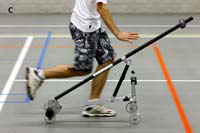An
article (subscription required) published in
Science this week (preprint available from authors at their
project site) proposes an addition to knowledge about why a bike in motion tends to go straight & stay upright. As explained by
Cornell's Chronicle Online, if "the center of mass of the front steering assembly ... is lower than that of the rear frame and forward of the steering axis ...." then if the moving bike starts to fall, "the front tends to fall faster, and this causes it to turn in the direction of the fall," and it recovers. Apparently this effect works at the same time as the conventional wisdom about the gyroscopic effect and front wheel trailing behind the steering axis, but they've also proven it works independently of those two effects.
 |
| Test device which cancels out the gyroscopic and trailing effects, yet is still stable |
There's a video (
download) at the Cornell article which offers some explanation.
So, huh.
(via
Engadget)


No comments:
Post a Comment